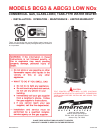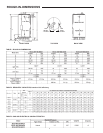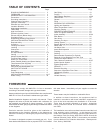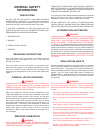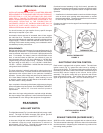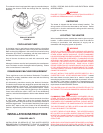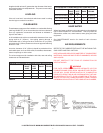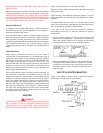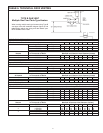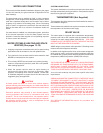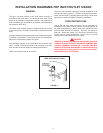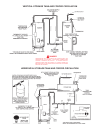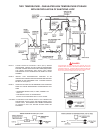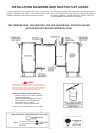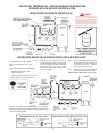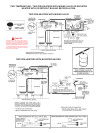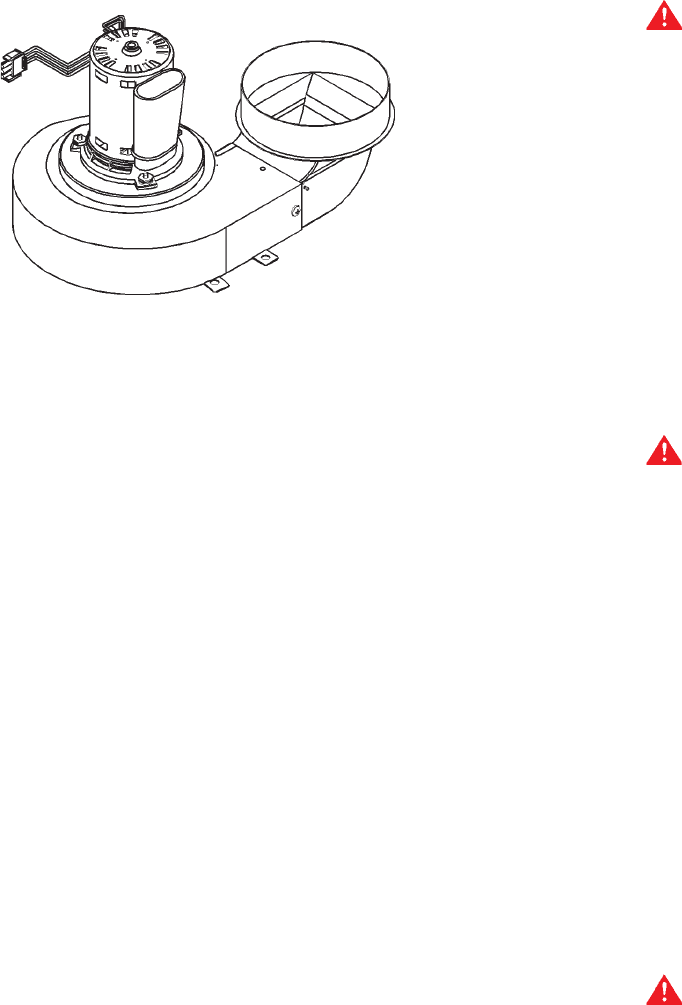
6
The exhaust inducer is equipped with a gravity controlled damper
to reduce the amount of heat loss through the flue, improving
efficiency.
EXHAUST INDUCER
FIGURE 4
CIRCULATING PUMP
A circulating pump is used when a system requires a circulating
loop or there is a storage tank used in conjunction with the heater.
Refer to the piping diagrams in this manual for electrical hookup
information and install in accordance with the latest version of
the National Electrical Code ANSI/NFPA No. 70.
Only all bronze circulators are used with commercial water
heaters.
Although circulators are oiled and operated by the manufacturer
some circulators must be oiled again before operating. Please
refer to manufacturer’s instructions.
DISHWASHING MACHINE REQUIREMENT
These appliances meet the National Sanitation Foundation
Standard for sanitary installations when used with the following
leg kit, Part No. 6570-7.
All dishwashing machines meeting the National Sanitation
Foundation requirements are designed to operate with water flow
pressures between 15 and 25 psi. Flow pressures above 25 psi,
or below 15 psi, will result in improperly sanitized dishes. Where
pressures are high, a water pressure reducing or flow regulating
control valve should be used in 180
0
F line to the dishwashing
machine, and should be adjusted to deliver water between these
limits.
The National Sanitation Foundation also recommends circulation
of 180
0
F water. Where this is done, the circulation should be
very gentle so that it does not cause any unnecessary turbulence
inside the water heater. The circulation should be just enough to
provide 180
0
F water at the point of take-off to the dishwashing
machine. Adjust flow by means of the plug cock in the circulating
line.
INSTALLATION INSTRUCTIONS
REQUIRED ABILITY
INSTALLATION OR SERVICE OF THIS WATER HEATER
REQUIRES ABILITY EQUIVALENT TO THAT OF A LICENSED
TRADESMAN IN THE FIELD INVOLVED. PLUMBING, AIR
SUPPLY, VENTING, GAS SUPPLY AND ELECTRICAL WORK
ARE REQUIRED.
WARNING
FAILURE TO FOLLOW THESE INSTRUCTIONS CAN RESULT
IN SERIOUS PERSONAL INJURY OR DEATH.
UNCRATING
The heater is shipped with the inducer already installed. The
wiring conduit runs from the thermostat to the inducer. Before
turning unit on, check to make sure the wiring conduit is securely
plugged into the inducer.
LOCATING THE HEATER
When installing the heater, consideration must be given to proper
location. Location selected should be as close to the stack or
chimney as practicable, with adequate air supply and as
centralized with the piping system as possible.
WARNING
THERE IS A RISK IN USING FUEL BURNING APPLIANCES
SUCH AS GAS WATER HEATERS IN ROOMS, GARAGES OR
OTHER AREAS WHERE GASOLINE, OTHER FLAMMABLE
LIQUIDS OR ENGINE DRIVEN EQUIPMENT OR VEHICLES ARE
STORED, OPERATED OR REPAIRED. FLAMMABLE VAPORS
ARE HEAVY AND TRAVEL ALONG THE FLOOR AND MAY BE
IGNITED BY THE HEATER’S PILOT OR MAIN BURNER FLAMES
CAUSING FIRE OR EXPLOSION. SOME LOCAL CODES
PERMIT OPERATION OF GAS APPLIANCES IN SUCH AREAS
IF THEY ARE INSTALLED 18” OR MORE ABOVE THE FLOOR.
THIS MAY REDUCE THE RISK IF LOCATION IN SUCH AN AREA
CANNOT BE AVOIDED.
DO NOT INSTALL THIS WATER HEATER DIRECTLY ON A
CARPETED FLOOR. A FIRE HAZARD MAY RESULT.
Instead
the water heater must be placed on a metal or wood panel
extending beyond the full width and depth by at least 3 inches in
any direction. If the heater is installed in a carpeted alcove, the
entire floor shall be covered by the panel. Also, see the DRAINING
requirements in MAINTENANCE Section.
THE HEATER SHALL BE LOCATED OR PROTECTED SO IT IS
NOT SUBJECT TO PHYSICAL DAMAGE BY A MOVING VEHICLE.
WARNING
FLAMMABLE ITEMS, PRESSURIZED CONTAINERS OR ANY
OTHER POTENTIAL FIRE HAZARDOUS ARTICLES MUST
NEVER BE PLACED ON OR ADJACENT TO THE HEATER. OPEN
CONTAINERS OR FLAMMABLE MATERIAL SHOULD NOT BE
STORED OR USED IN THE SAME ROOM WITH THE HEATER.
THE HEATER MUST NOT BE LOCATED IN AN AREA WHERE
IT WILL BE SUBJECT TO FREEZING.
LOCATE IT NEAR A FLOOR DRAIN. THE HEATER SHOULD
BE LOCATED IN AN AREA WHERE LEAKAGE FROM THE
HEATER OR CONNECTIONS WILL NOT RESULT IN DAMAGE
TO THE ADJACENT AREA OR TO LOWER FLOORS OF THE
STRUCTURE.
WHEN SUCH LOCATIONS CANNOT BE AVOIDED, A SUITABLE
DRAIN PAN SHOULD BE INSTALLED UNDER THE HEATER.
Such pans should be fabricated with sides at least 2" deep, with



